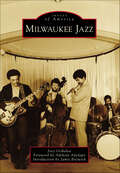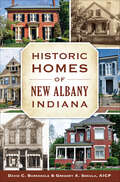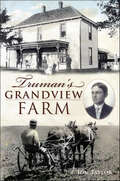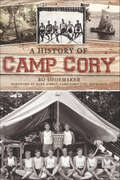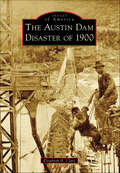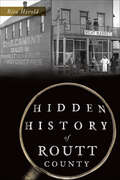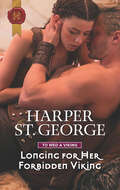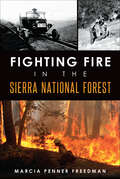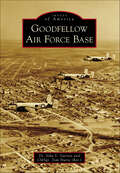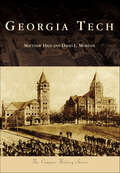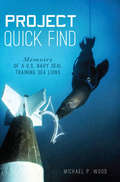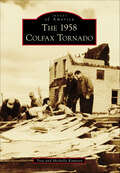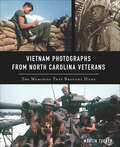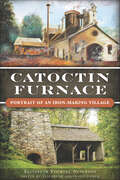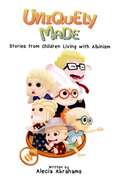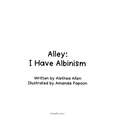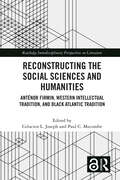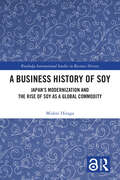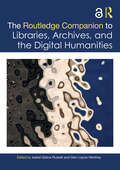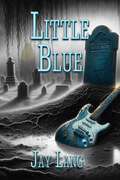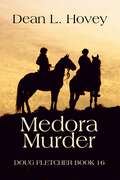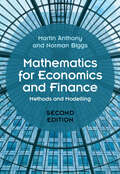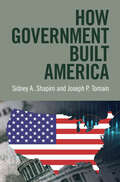- Table View
- List View
Milwaukee Jazz (Images of America)
by Joey GrihalvaMilwaukee's jazz scene has forever stood in the shadow of Chicago's illustrious institution, but it stands strong. Cream City has produced a wealth of talent, attracted top-notch transplants, and hosted legends like Duke Ellington, Dizzy Gillespie, Herbie Hancock, Billie Holiday, and Wynton Marsalis. From the heyday of the 1940s and 1950s to the renaissance of the 1970s, from the streets to the classrooms, from grand ballrooms to outdoor festivals, from swing to bebop, from smoky bars to dimly lit clubs like the Flame, Thelma's Back Door, and the Jazz Gallery, Milwaukee has been a hotbed of improvised music, providing a noteworthy contribution to the story of jazz in America.
Historic Homes of New Albany, Indiana (Landmarks Ser.)
by David C. BarksdaleNew Albany's historic homes boast unique histories and fascinating stories of those who inhabited them. Founded in 1813 below the falls of the Ohio River, the city was Indiana's most populous by the middle of the nineteenth century. Many leading citizens built grand mansions and family dwellings that beamed with prosperity and influence. The architectural legacy during these formative years continued into the early twentieth century and produced historic neighborhoods with a rich collection of housing styles. Join authors David C. Barksdale and Gregory A. Sekula as they delve into the history of New Albany's most cherished old homes.
Truman's Grandview Farm
by Jon TaylorThe rolling hills of southern Jackson County still shelter the white and green farmhouse Harry S. Truman occupied in the days before his journey to the Presidency. After the death of his father, the duties of the six hundred acre farm fell to twenty-two year-old Harry, who shouldered them from 1906 to 1917. It was here, in Grandview, that his nine year courtship with Bess Wallace took place and his ties with organizations like the Free Masons were forged. Drawing on photographs, letters and even farm receipts, historian Jon Taylor pieces together a picture of the farmer from Missouri whose humble beginnings prepared him to lead the country.
A History of Camp Cory (Landmarks)
by Bo ShoemakerSummertime memories of Camp Cory are awash in warm emotion. From the Reveille bugle at first light to Taps in the evening, those days were the absolute best. Skippering a K-boat on cool Keuka Lake. Silly songs and skits performed into the night. The boundless nature of genuine friendship. It is hard to explain exactly why that time is so special, how it changes lives forever. This wonderful mystery is revealed here by official Camp Cory historian Bo Shoemaker. So gather around the campfire to reminisce. Just be sure to watch out for the H Man!
The Austin Dam Disaster of 1900 (Images of America)
by Elizabeth H. ClareThe Austin Dam Disaster of 1900 recreates the era of Gay Nineties Austin, then--as now--a city on the rise and on the make. In 1891, at the behest of ambitious city fathers, the little city of just 15,000 people gambled its future on a project of breathtaking size--a massive hydroelectric dam across the Colorado River. This book follows the epic construction project and the brief golden era of the pleasure resort at Lake McDonald. Though troubled and controversial from the get-go, the dam embodied all of Austin's dreams. Then, on Friday, April 6, 1900, it began to rain . . .
Hidden History of Routt County (Hidden History)
by Rita HeroldSettling Routt County was never easy or safe. Fugitives used the undeveloped landscape as an "outlaw trail" to evade authorities. The inexorable Harry Tracy managed three jailbreaks before being killed by a posse. Conversely, many of the first families left entrepreneurial legacies. Widowed Alice Bartz sold the family homestead to start the Bartz Hotel in her Steamboat Springs' bakery and house, serving three meals a day to locals and guests. Others families, like the Nays and the Laughlins, were able to cut hay and raise enough livestock to pass the land down to future generations. Native author Rita Herold preserves oral histories and nearly forgotten episodes of the county's past.
Longing for Her Forbidden Viking (To Wed a Viking #2)
by Harper St. George“A deeply sensual, evocative, mesmerizing and fabulously intriguing story . . . I hand on heart cannot recommend this book and this series enough.” —Chicks, Rogues and ScandalsSaxon maiden Ellan would rather wed a Dane than be forced into marriage by her father. In fact, she has one Dane in mind. But strong warrior Aevir has been ordered to marry for duty—all he can offer Ellan is a place as his concubine!She may be bold, but Ellan can never accept that. Even if his burning kisses make it incredibly tempting . . .“Harper St. George is a must-buy for me!” —Terri Brisbin, USA Today–bestselling author
Fighting Fire in the Sierra National Forest
by Marcia Penner FreedmanTo live in the foothills on the periphery of the Sierra National Forest is to live with the certainty of summer wildfires. Each year, from April forward, Californians watch the sky and sniff the air for telltale signs of smoke. While fire remains a constant threat, the strategy for combating it has evolved with the understanding of its beneficial role in the forest environment. Marcia Penner Freedman traces the history of firefighting and fire management from the forest's early years through the policy shifts that began in the 1960s and the measures used today.
Goodfellow Air Force Base (Images of America)
by John V. GarrettGoodfellow Air Force Base is one of the oldest installations in the US Air Force. It was the first of scores of flying training fields established across Texas and Oklahoma during World War II. What qualified San Angelo as the site for the first of the new fields did not, for the most part, distinguish it much from its neighbors. The clear skies and flat, forgiving terrain so desirable in the training of pilots were regional qualities. But San Angelo also had Bob Carr, a former military aviator who spearheaded a local effort to provide land, an important railroad spur, and key utility connections if the new pilot school were built nearby. Over the next eight decades, nurtured by a special relationship between city and base, Goodfellow has distinguished itself by training more than 400,000 pilots, intelligence operators, and firefighters for all the armed forces of the United States.
Georgia Tech (Campus History)
by Matthew HildGeorgia Tech has become one of the nation's top-10-ranked public universities and boasts a former U.S. president, TV personality and Hall-of-Fame athletes among its prominent alumni.From humble beginnings as a small technological institute that opened in 1888, Georgia Tech is now renowned throughout the world for its excellence in technological education and research. A top-10-ranked public university, according to U.S. News & World Report rankings, famous Georgia Institute of Technology alumni include Jimmy Carter, G. Wayne Clough, Jeff Foxworthy, Sam Nunn, Randolph Scott, and Leonard Wood, along with many famous athletes. Georgia Tech has won four national college football championships, the first in 1917 under the legendary coach John Heisman. Today, Georgia Tech has a student body of more than 29,000 at the undergraduate and graduate levels and more than 155,000 living alumni. The institute has an annual economic impact of about $3 billion upon Georgia's economy. Authors and Tech alumni Matthew Hild and David L. Morton take you inside the journey of how this institute got to where it is today.
Project Quick Find: Memoirs of a U.S. Navy SEAL Training Sea Lions
by Michael P. WoodProject Quick Find is the true story of sea lions trained to help U.S. Navy SEALs. Begun in Hawaii in the late 1960s, the project recruited trainers in Coronado, California, to successfully teach the animals to recover objects from the ocean floor. The program eventually received official navy certification, expanded its scope and evolved its mission. Author, photojournalist and former Navy SEAL Michael P. Wood documented the program in the 1970s and presents this fascinating look at the bond between man and beast.
The 1958 Colfax Tornado (Images of America)
by Troy KnutsonJune 4, 1958, was a muggy and breezy day in western Wisconsin. Across central Minnesota, severe weather was brewing. In the early afternoon, the Minnesota storms crossed the border into Wisconsin. As farmers were tending to milking chores and families were wrapping up the workday and sitting down to supper, one of the worst tornadoes in Wisconsin's history touched down. At 7:07 p.m., what had been multiple, smaller tornadoes combined into one massive F5 tornado that ripped through the village of Colfax, leaving a path of death and destruction that would require months of recovery. In Colfax, 12 people were killed, hundreds were injured, and millions of dollars in damage was done to property. However, in the wake of the storm, a community and its neighbors came together as one to care for the survivors and begin the process of healing and rebuilding.
Vietnam Photographs from North Carolina Veterans: The Memories They Brought Home
by Martin TuckerWhen American soldiers returned home from Vietnam, most put their memories away. Decades later, North Carolina veterans contributed thousands of dusty and faded personal photographs to what started as a class project at the Sawtooth School for Visual Art in Winston-Salem. It evolved into a national traveling exhibition and then a permanent collection of the North Carolina Museum of History called "A Thousand Words: Photographs by Vietnam Veterans." For many of these men and women, this was their first opportunity to show what they couldn't say. Photographer and Vietnam-era vet Martin Tucker presents selected glimpses of those unforgettable experiences.
My Brother Slaves: Friendship, Masculinity, and Resistance in the Antebellum South (New Directions In Southern History Ser.)
by Sergio LussanaTrapped in a world of brutal physical punishment and unremitting, back-breaking labor, Frederick Douglass mused that it was the friendships he shared with other enslaved men that carried him through his darkest days. In this pioneering study, Sergio A. L
Catoctin Furnace: Portrait of an Iron Making Village (Landmarks)
by Elizabeth Yourtee AndersonOn the eve of the American Revolution, the Johnson brothers founded Catoctin Furnace near present-day Thurmont. Catoctin iron was turned into bombshells used against the British at the Battle of Yorktown. After the colonies won their independence, business boomed for the ironworks. The labor of African slaves and European immigrants produced household goods, tools and stoves for the young country. A small iron-making village evolved around the industry, and though the furnace closed in 1903, its legacy is still remembered and celebrated today. It was rescued from imminent destruction in the 1960s and is now listed on the National Register of Historic Places. This proud history was chronicled in full by beloved local historian Elizabeth Yourtee Anderson. Discover the story of Catoctin Furnace, which for more than 130 years helped define the industry, history and culture of western Maryland.
Uniquely Made: Stories from Children Living with Albinism
by Alecia AbrahamsThe book, "Uniquely Made: Stories from Children Living with Albinism" by Alecia Abrahams, explores the lives and experiences of children with albinism across different cultural and geographical contexts. It highlights the challenges they face, the discrimination they encounter, and the unique aspects of their condition while delivering inspiring messages about resilience, self-acceptance, and kindness.
Alley I Have Albinism
by Alethea AllenWritten by Alethea Allen and illustrated by Amanda Papoon, this heartwarming children’s book introduces readers to Alley, an eight-year-old girl with albinism. Through her story, Alley shares her vibrant personality, love for art, dancing, and writing, while also explaining the challenges and unique aspects of living with albinism. Alley proudly embraces her differences, highlighting her resilience and the support of her family and friends. The book serves as an educational and uplifting tale, encouraging understanding, kindness, and self-acceptance.
Reconstructing the Social Sciences and Humanities: Anténor Firmin, Western Intellectual Tradition, and Black Atlantic Tradition (Routledge Interdisciplinary Perspectives on Literature)
by Paul C. Mocombe Celucien L. JosephJoseph Anténor Firmin (1850–1911) was the reigning public intellectual and political critic in Haiti in the nineteenth century. He was the first “Black anthropologist” and “Black Egyptologist” to deconstruct the Western interpretation of global history and challenge the ideological construction of human nature and theories of knowledge in the Western social sciences and the humanities. As an anti-racist intellectual and cosmopolitan thinker, Firmin’s writings challenge Western ideas of the colonial subject, race achievement, and modernity’s imagination of a linear narrative based on the false premises of social evolution and development, colonial history and epistemology, and the intellectual evolution of the Aryan-White race. Firmin articulated an alternative way to study global historical trajectories, the political life, human societies and interactions, and the diplomatic relations and dynamics between the nations and the races.Reconstructing the Social Sciences and Humanities is the first full-length book devoted to Joseph Anténor Firmin. It reexamines the importance of his thought and legacy, and its relevance for the twenty-first century’s culture of humanism, and the continuing challenge of race and racism.
A Business History of Soy: Japan’s Modernization and the Rise of Soy as a Global Commodity (Routledge International Studies in Business History)
by Midori HiragaThis is a business history of soy that reveals how Japanese imperial and military institutions and financial-mercantile-industrial interests created a role for soy as a versatile raw material and global commodity beginning in the 19th century, even before the Western world recognized this “oilseed.” Originating in the rich food cultures of Asia, soy is praised as the “magic bean.” About 360 million tons are produced in the world today, and it is traded globally to become food, feed, and fuel. It is the second largest source of vegetable oil in the world, and soy meal is an essential feed without which the modern livestock industries could not exist. Its dominance today is often accounted for in terms of its versatile nature. This book, however, argues that soy was transformed into a versatile industrial raw material and global commodity through the political-economic strategies of state and business actors engaged in the development of the capitalist world-economy. By studying little-known Japanese historical documents and corporate records, and focusing on the less-researched vegetable oil and industrial uses of soy, this book provides a better understanding of how this traditional Asian food was transformed into a global commodity embedded in contradictions. Promoted as a healthy and sustainable food source, soy is also a destructive cash crop whose cultivation and use have played a significant role in the current climate crisis. Based on this case of soy, the book provides a structural understanding of broader food and agriculture systems in the history of capitalism, making it of interest to students at an advanced level, academics, and researchers in the fields of business history, corporate governance, Japanese business, as well as the political economy of food and agriculture.Chapters 2, 3, and the Conclusion of this book are freely available as a downloadable Open Access PDF at http://www.taylorfrancis.com under a Creative Commons Attribution-Non Commercial-No Derivatives (CC BY-NC-ND) 4.0 license.
The Routledge Companion to Libraries, Archives, and the Digital Humanities (Routledge Companions to the Digital Humanities)
by Isabel Galina Russell Glen Layne-WortheyThe Routledge Companion to Libraries, Archives, and the Digital Humanities covers a wide range of issues encountered in the world’s libraries and archives as they continue to expand their support of, and direct engagement in, Digital Humanities (DH) research and teaching. In addition to topics related to the practice of librarianship, and to libraries and archives as DH-friendly institutions, we address issues of importance to library and archives workers themselves: labour, sustainability, organisation and infrastructure, and focused professional practices that reflect the increasingly important role of librarians and archivists as active research partners. One of the central motifs of this book is that the “two” fields—DH, on the one hand, and the library, archival, and information sciences on the other—are in fact deeply intertwined, productively interdependent, and mutually reinforcing. We place these on an equal footing, considering how they coexist and collaborate in equal partnership.This Companion will be of interest to DH practitioners and theorists, especially those who work in libraries and archives, and those who work with them. Likewise, “non-DH” (or “not-yet-DH”) library and archival administrators, reference and public service librarians, cataloguers, and even those who work primarily with the tangible collections will find here echoes and implications of the most venerable traditions and practices of our shared profession.The Introduction of the book is free-to-view at https://www.book2look.com/book/hpV4zdnW6q.Chapter 14 of this book is freely available as a downloadable Open Access PDF at http://www.taylorfrancis.com under a Creative Commons Attribution-Non Commercial-No Derivatives (CC-BY-NC-ND) 4.0 license.Chapter 17 of this book is freely available as a downloadable Open Access PDF at http://www.taylorfrancis.com under a Creative Commons Attribution-Non Commercial-No Derivatives (CC-BY-NC-ND) 4.0 license.Chapter 8 and 18 will be made Open Access.
Little Blue
by Jay LangJude works as a low-paid janitor in a boxing gym. One fateful night he encounters Mad Madge, a homeless woman claiming she can reconnect him with his daughter. Desperate and intoxicated, he consumes a strange serum and is thrust into a nightmarish realm. There, Little Blue’s spirit reveals that a snake-tattooed man is responsible for her death, igniting a fierce hunger for vengeance when Jude awakens in a hospital bed. Nothing will stop Jude from seeking revenge for his little girl. However, he is unprepared for the lengths some will go to protect their secrets and power.
All in the Furry Family: Cat Tales Book Two (Cat Tales)
by Eileen O'FinlanCan a cat be a bridezilla? In Fauanburg she can in this delightful sequel to All The Furs and Feathers. The success of Oneness Park has brought big changes to town. Smokey is now Abigail Fluffington’s partner at Fluffington ArCATechture. Autumn Amelia runs the wildly popular Mama Cat’s Kitchen. But it’s not all fun and games. Two strange cats are stalking Smokey. When she finally confronts them, she gets the shock of a lifetime. Meanwhile, Greyson and Abigail Fluffington's wedding is threatened as Abigail keeps changing her mind about the menu, the cake, the flowers, even the invitations. Her antics are driving all the furs and feathers crazy!
Medora Murders: Doug Fletcher Book 16 (Doug Fletcher)
by Dean L. HoveyDoug and Jill Fletcher are dispatched to investigate the origin of a human bone discovered inTheodore Roosevelt National Park. Barely set up in the horse campground, they’re confronted with the disappearance of a woman and her teen daughter from a nearby campsite .After determining that the missing women are still in the park, the Fletchers coordinate a search effort across the 110 square milesof the park as thunderstorms threaten to ignite lightning fires and the Little Missouri River swells past its banks making portions of the park inaccessible.
Mathematics for Economics and Finance: Methods And Modelling
by Martin Anthony Norman BiggsAccessible, concise, and interactive, this book introduces the mathematical methods that are indispensable in economics and finance. Fully updated to be as student friendly as possible, this edition contains extensive problems, worked examples and exercises (with full solutions at the end of the book). Two brand new chapters cover coupled systems of recurrence/differential equations, and matrix diagonalisation. All topics are motivated by problems from economics and finance, demonstrating to students how they can apply the mathematical techniques covered. For undergraduate students of economics, mathematics, or both, this book will be welcomed for its clarity and breadth and the many opportunities it provides for readers to practise and test their understanding.
How Government Built America
by Joseph P. Tomain Sidney A. ShapiroHow Government Built America challenges growing, anti-government rhetoric by highlighting the role government has played in partnering with markets to build the United States. Sidney A. Shapiro and Joseph P. Tomain explore how markets can harm and fail the country, and how the government has addressed these extremes by restoring essential values to benefit all citizens. Without denying that individualism and small government are part of the national DNA, the authors demonstrate how democracy and a people pursuing communal interests are equally important. In highly engaging prose, the authors describe how the government, despite the complexity of markets, remains engaged in promoting economic prosperity, protecting people, and providing an economic safety net. Each chapter focuses on a historical figure, from Lincoln to FDR to Trump, to illustrate how the government-market mix has evolved over time. By understanding this history, readers can turn the national conversation back to what combination of government and markets will best serve the country.
